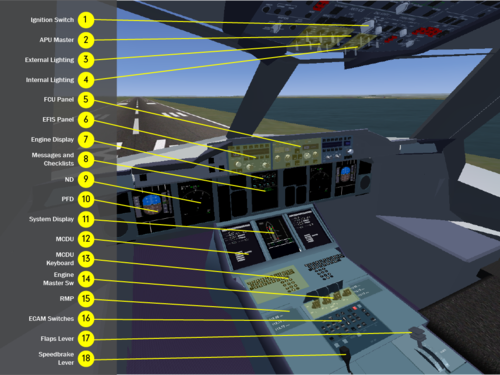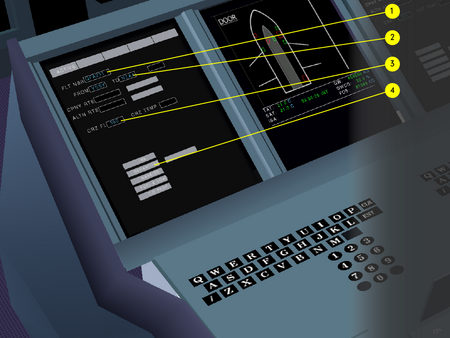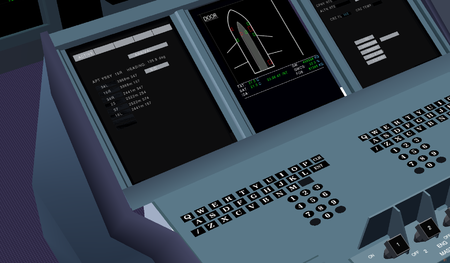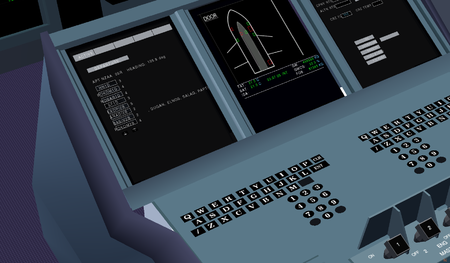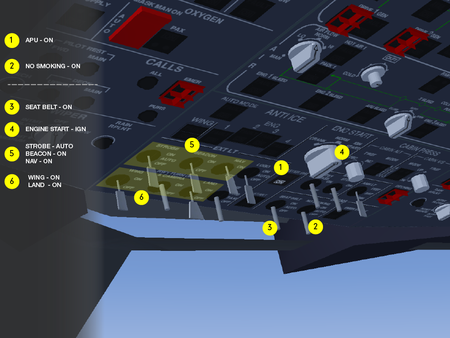A380 Tutorial
This is a draft working version of a tutorial to help understand how to fly the A380, and use Airbus Flight Guidance systems
Flying the A380
Objectives
This tutorial takes a 3 hour flight from Sydney (YSSY) to Auckland (NZAA) and will help;
- Familiarise you with key cockpit controls
- Provide guidance on weight control
- Introduce features of the Airbus Flight Guidance controls
- Introduce operation of Flight Management Systems
You would find several tutorial that teach you how to fly or use FlightGear.
Before You Start
FMS Database Files
Before starting FlightGear you will need to download and install copies of FMS database files for the airports you will fly from and to. The A380 FlightGear model uses the Level-D 767 XML Format files for the Flight Management System. There are many web sites that have these files available for download, some require a paid subscription and are updated regularly, others provide them for free.
One of the most complete free websites is www.navdata.at from the front page of the site;
- click on "SID/STAR" in the top navigation bar,
- then click on "Download" from the left-hand menu,
- select "Level-D 767" from the available addons drop-down list (note: this is different than "767PIC")
- select "YSSY - Sydney" from the stored airports drop-down list, then click on the little folder icon for the most recent version in the table
- save the ZIP file somewhere, we will un-zip it later.
- select "NZAA - Auckland" from the stored airports drop-down list, again click on the folder icon to download and save somewhere you can remember.
Under the A380 root (which is under <FG-Home>/data/Aircraft/A380) there is a directory called FMS/ this will be initially empty (except for a README file), open the previously downloaded ZIP files, and extract the YSSY.xml and NZAA.xml into the FMS/ directory.
YSSY Models
For this tutorial you should also download YSSY terminal models. Visit the wiki page Sydney International Airport and at the end of the article is a link to download models for YSSY, simply unpack either the tbz (for Linux and Mac users) or zip (for Windows users) file under <FG-Home>/data/
Scenery Tiles
If you haven't downloaded the scenery tiles around Sydney Airport, you should start Terrasync and then start FlightGear at YSSY, this will pre-load the scenery tiles for the airport ready for our tutorial flight, leave it running for a minute or two to download as much scenery around the airport as it can. This will mean the scenery tiles will exist in the directory maintained by terrasync, and the airport models will exist under the $FG_ROOT directory.
Overview of Cockpit Components
- Ignition start switch
- APU Master start switch
- External Lighting switches - includes strobe, landing, beacon etc
- Internal Lighting switches - includes no smoking, seat belts and storm
- Flight Control Unit (FCU) Panel - controls speed, heading, altitude and vertical speed
- EFIS Panel - include barometric pressure, PFD data display and Nav Display range
- Engine Display - displays N1, N2, EGT
- Messages, Warnings and Checklist display (along with Engine Display above form the "E/W Display")
- Navigation Display (ND)
- Primary Flight Display (PFD)
- System Display (SD/ECAM)
- Multi-Function Display (MFD) screens - display FMGS information
- Keyboard and Corsor Control Units (KCCD) Keyboard and num-pad for entering FMGS information
- Engine Master Switches
- Radio Management Panel (RMP)
- ECAM selection switches
- Flaps lever
- Speedbrake/Ground Spoilers lever
The MFD and KCCD combination would be one unit in previous Airbus aircraft (ie: A320, A330, A340) and called a Multifunction Control Display Unit (MCDU)
The Airbus philosophy for the overhead panel is so called "lights out", that is during normal flight nothing should be illuminated on the overhead panel. However the opposite is true for the Flight Control Unit (FCU) on the glareshield; the Flight Director, one of the Auto Pilots and Auto Thrust should be illuminated.
Introduction to the FCU
The Flight Control Unit is in the middle of the glareshield, it has controls for the Flight Guidance System to set;
- speed,
- heading,
- altitude and
- vertical speed.
This unit is common across all Airbus aircraft built from the A320 onwards. Each of the four Flight Guidance parameters (ie: speed, heading, altitude, V/S) can operate in either "selected" or "managed" modes when the autopilot is engaged. The current Thrust, Vertical and Lateral modes are shown across the top line of the Primary Flight Display (PFD) as Flight Mode Annunciators (FMA).
Selected Mode
Selected Mode is engaged when the knob is pulled by using the Middle Mouse Button (MMB). Use the scrollwheel on your mouse to change the value for that parameter, you can also dial in a value with the scrollwheel while the parameter is in managed mode, and it won't affect the current flight controls until you engage selected mode. The specific Flight Guidance Modes for each of the parameters are;
| Flight Parameter | Specific Selected Modes |
|---|---|
| SPEED | SPEED, MACH |
| HEADING | HDG |
| ALTITUDE | ALT |
| Vertical Speed | V/S |
If both Altitude and Vertical Speed parameters are in selected mode, the flight guidance with follow the vertical speed until the specified altitude has been reached, then the aircraft will remain at that altitude until the altitude value is changed or the altitude parameter managed mode is engaged.
If you don't have a scrollwheel on your mouse, you really should consider getting one, however as a workaround you can change the value of selected mode parameters by pressing F11 to bring up the autopilot dialog window, however you can only change values for a parameter when it is in selected mode. If you do have a scrollwheel and a two button mouse, you shouldn't use the F11 Autopilot dialog window, as the Auto Flight System will overwrite your set values when in managed mode.
Managed Mode
Managed Mode is engaged when the knob is pushed by using the Left Mouse Button (LMB) (which may be on the right if you swap your mouse buttons around because for example you are left-handed). When in Managed Mode the value for the parameter will change to a number of dashes "-". You should only use Managed Mode if you have built a flight plan in the FMS on the MCDU screen. Managed Mode is managed by the Flight Management System and is based on the phase of flight and the flight plan entered depending on the parameters;
| Flight Parameter | Managed Mode name | Managed function |
|---|---|---|
| SPEED | THR CLB, THR CRZ, THR DES | Based on phase of flight from Climb, Cruise and Descent and data entered in PERF page on FMS |
| HEADING | NAV, LOC | Follows waypoints in the autopilot flight plan or the localiser signal on NAV1 radio frequency during approach |
| ALTITUDE | CLB, ALT CRZ, DES, G/S | Follows altitude restrictions in the autopilot flight plan and configured cruise altitude in FMS or the Glidescope signal on NAV1 frequency during approach |
Generally pilots engage the autopilot shortly after take-off and leave it engaged until they have visual contact with the runway and use a combination of selected and managed modes during the flight.
QFA231
Scheduled flight Qantas 231 will depart Gate 57 from Sydney International Airport to Auckland International Airport with flight time of around 3 hours.
Pre-flight
Fuel Estimates
Our fuel estimates for this flight are around 20 000kg for the 1 180 NM (which is less than 10% of the range of the aircraft) which is almost impossible to achieve for this aircraft, so we will refuel around 60 000kg.
Flight Plan
Cruise: FL350
YSSY depart 16R
SID: KAMPI 1
GEROS
STAR: ARADI 4B
NZAA approach 05R
Starting FlightGear
Start FlightGear with the following options;
| Option | Value |
|---|---|
| terrasync | enabled with atlas protocol and scenery directory pointing to both default scenery and terrasync directories (see below) |
| fg-scenery | $FG_ROOT/data/Scenery:<terrasync-scenery-dir> |
| atlas | socket,out,1,localhost,5500 udp |
| airport | YSSY |
| parkpos | Intl057 |
| timeofday | afternoon |
| prop:sim/paths/use-custom-scenery-data | false (only required for FlightGear versions after 2.0.0) |
| aircraft | A380 |
| enable-real-weather-fetch |
In a different terminal window start Terrasync with a command line something like; "nice ./terrasync -S -p 5500 -d <terrasync-scenery-dir>" also if there is ATC controlling the airport you may want to start FGcom if you have a headset with microphone.
Fuelling and Weight
Adjust your view to the System Display (11) so that you can read the GWCG and FOB values, then from the menu select Equipment > Fuel and Payload. The optimum Centre-of-Gravity value (GWCG) is around 32%, however values between 30% and 40% can be used depending on fuel burn estimates (ie: the further you have to travel, the more fuel you can burn, the more the offset towards 40% it can start at, as the CG will go towards 40% as we burn and transfer fuel)
- Firstly adjust fuel tanks 0 and 3 down to around 9500 lbs
- adjust fuel tanks 4 and 5 to around 9500 lbs
- adjust fuel tanks 6 and 7 to around 9200 lbs
- adjust fuel tanks 8 and 9 to around 7500 lbs
- check GWCG if it is above 36% then
- add fuel to trim tank number 10 and,
- add cargo to the bulk and aft cargo areas
- if it is less than 32% then;
- reduce fuel in the trim tank 10 and,
- add cargo to the forward cargo area and,
- reduce cargo from bulk and aft cargo area
So for this short flight aim to have Fuel-On-Board around 60 000 kilograms and as close to 32-33% Centre-of-Gravity
Pre-flight Checklists
There are two checklists presented here, the first is a more complete preparation checklist that is performed upon entering the cockpit, the second pre-flight checklist is performed on every departure.
Cockpit Preparation Checklist
The cockpit preparation checklist is done at the first flight of the day or where there has been a change-over of crew. It starts at the top left-hand corner of the overhead panel, moves down the left hand-side of the panel, then start at the top of the middle of the panel and work your way down, then across the glareshield panel from left to right, then straight down the front panel and then pedestal.
- move your way down and check each section;
- ADIRS
- Probe and Window Heat
- Flight Control (F/CTL)
- Fuel Jettison
- Evacuation
- Emergency Electrical Power
- Entertainment
- Oxygen
- Calls and Wiper
- Engine Fire
- Hydraulics Panel
- Fuel Panel
- Electrical Panel
- ensure that NO button is in the OFF status
- click ON if EXTERNAL power is AVAIL
- Cargo Air
- Air Panel (ensure packs and hot-air are OFF)
- Cargo Smoke
- Vents (avionics fan should be on if heavy rain)
- Anti Ice panel (wing anti-ice should be OFF while on the ground)
- External Lighting (only NAV lights should be ON if the aircraft is powered)
- Engine Start (should be in NORM position)
- click the APU Master Sw ON
- the APU ECAM page should be automatically displayed
- Cabin Pressure (should be in AUTO mode)
- Internal Lighting
- click ON STORM if you are flying at night
- click the NO-SMOKING switch to AUTO
Now move to the Glareshield;
- starting with the EFIS panel, click the darker coloured outer ring of the Barometer knob for either hectopascals or inches of mercury, use the mouse scrollwheel on the lighter coloured inner knob to adjust the barometer value to the current pressure reported under the menu option Environment > Global Weather. Each increment of the barometer value is 0.33 hPa, so it takes three increments to increase from 1013 hPa to 1014 hPa.
- click the Flight Director (FD) ON
- moving down the front panel, check the lower message section of the E/WD
- check standby instruments, and autobrake is set to RTO
- moving down to the pedestal, check the System Display permanent data area, that the time is correct, the temperature is correct, Fuel On Board is correct, and Gross Weight is correct
- ensure all ENG MASTER switches are in the OFF position
- by now the APU should be supplying power (to display the APU status, click the APU button on the ECAM selection panel); check supply voltage and the word 'AVAIL' is present
- check flaps lever is fully retracted at 0 and speed-brake/spoilers are retracted
- lastly check the park-brake is ON (displayed on the E/W Display)
Pre-flight Checklist
The pre-flight checklist is less arduous than the preparation checklist and is performed on every departure once route verification has been completed, about 15 minutes before departure.
This completes our pre-flight preparation checklist, if you are at a ATC controlled airport you would normally request departure information at this point.
Entering Flight Plan
Adjust your view and zoom into the left-hand captains MCDU display, ensure you can see the full display and the MCDU keyboard and num-pad, this first page is the 'INIT' page for the 'ACTIVE' flight plan. To use the MCDU, you use your mouse to click inside a field, then click on the keys on the MCDU keyboard and num-pad below (don't use your physical keyboard to enter values)
ACTIVE INIT page
- First click inside FLT NBR field, then set the Flight Number to QFA231
- click inside the TO field and enter our destination airport NZAA
- next click inside the CRZ FL field and enter our cruise flight level of 350
- click on the DEPARTURES option on the MCDU page, this will take you to the next page.
ACTIVE DEPARTURE page
- click on 16R from the list of runways
- now click on SID to go to the next page
ACTIVE DEPARTURE SID page
- click on KAMPI1, as there are no transition points for this SID, you will now go to the next page
ACTIVE ARRIVAL page
- click on 05R from the list of runways
- now click on STAR to go to the next page
ACTIVE ARRIVE STAR page
The two small up/down arrows at the end of the list of STAR procedures show that more options are available, you can click on the down arrow to go the next list of options, and the up arrow to go back.
- click on ARAD4B
- click on ACTIVE at the top of the page, a drop-down menu will appear, then select INIT.
We are going to add an extra waypoint (in future versions you will be able to modify the flight plan from MCDU, however for the moment we use the Route Manager dialog to do this)
- From the top menu click on Autopilot > Route Manager
- click on the line for "KAMPI"
- then click inside the orange input field and enter 'GEROS@35000' and click the Add button
- review the full flight plan, notice the Top-of-Descent pseudo-waypoint has been added
T.O. PERF page
Finally we set and review the takeoff performance data, from the INIT page;
- click on T.O. PERF
- note the V1 balanced field speed and the Vr rotate speed (Vr and V2 are calculated based on weight, pressure, altitude and temperature)
- for heavier loads, you should increase the 'THR RED altitude to 1400ft or 1500 ft
- review and modify the transition-altitude (TA) (the altitude above sea level at which aircraft change from the use of altitude to the use of flight levels - wikipedia) as appropriate for the departure airport.
Clicking the CLB tab allows to review CLB parameters (to be modeled in a future release)
Now is a good time to review your flight plan, from the top menu select Equipment > Map.
Start-up
With most of the passengers on-board and cargo loaded, it's almost our scheduled time for pushback. Close the cargo doors by pressing 'd' and 'D' on your keyboard, it will take some time for the doors to close (future release will allow clicking on the doors to open/close), watch the System Display DOORS page as the cargo door symbols turn from Red to Green. Do the same for the passenger doors by pressing '!' (Shift-1) then '@' (Shift-2) and the ECAM DOORS page will show the symbols turn Red to Green.
Before Start checklist
- Pilot should check the Takeoff(T.O.) Data; the co-Pilot may cross-check the T.O. Data
- Pilot flying should select the T.O. Tab on the T.O. Perf page on the MCDU
- click to AUTO the SEAT BELT switch on the overhead internal lighting panel with left-mouse-button
- click OFF any external power sources
- Request external power disconnection from ground crew (CTRL-e will toggle the connection of ground external power)
- Check all EXT AVAIL indicators on the overhead panel are not illuminated
- Obtain clearance for startup and pushback (use Equipment -> Pushback to display the pushback vehicle)
- check all doors are closed (should all be green)
- check thrust levers are at IDLE
- click the BEACON and STROBE to ON on the overhead external lighting panel
- check parking brake status is ON (displayed on E/W Display)
That completes the 'Before Start Checklist', you should now have obtained clearance for startup and pushback, and made contact with the ground crew for pushback who will request you to release the parking brake (Shift-B) to begin the pushback during or after the engine start procedure.
Items 1, 2, 3 and the NAV and BEACON of 5 should be ON or AUTO by now.
Automatic Startup Procedure
- click with left-mouse-button ENGINE START to IGN START on the overhead panel
- announce "Starting Engine 2 and 3" to ground crew
- click ON ENG MASTER 2 with your left-mouse-button
- the ENGINE ECAM page should automatically be displayed
- once N2 has reached 10%, click ON ENG MASTER 3
- both pilots should monitor the ECAM page and E/W Display as N1 and N2 increase and Oil pressure increases
- once N2 for ENGINE 3 has reached 25%;
- announce "Starting engine 1 and 4" to ground crew
- click ON ENG MASTER 1 and repeat steps 3 - 6 above for engines 1 and 4
- check engine idle parameters are normal (N1 = 20%, N2 = 60%, Fuel Flow = 765kg/h, EGT = 380C - 390C)
With the engines running at idle, the startup procedure is complete, continue to the 'After Start Checklist'
After Start checklist
- ensure the APU BLEED on the overhead AIR panel is no longer illuminated (otherwise ingestion of engine exhaust)
- using the middle-mouse-button click ENGINE START to NORM on the overhead panel
- check GND SPLRS are armed, RUD TRIM is reset
- set the FLAPS to 2
- set WING and ENGINE ANTI-ICE as required on the overhead panel (check E/W Display for "ANTI ICE CHECK" memo)
- click OFF APU MASTER Sw using left-mouse-button
- announce "Clear to Disconnect" to ground crew
while waiting for the ground crew to clear turn the park brake on by pressing Shift-B, check the E/W Display to see if it is ON. Request taxi instructions from Ground ATC. Once the ground crew are cleared and you have taxi instructions;
- click to TAXI the NOSE sw on the overhead external lighting panel with left-mouse-button
- click to ON WING on the overhead external lighting panel
- click to AUTO LOGO on the overhead external lighting panel if flying at night
- press Shift-B to release the parking brake
- increase throttle and taxi at around 15knots as directed by ATC to the holding point
- while taxing to the holding point, dial-up a selected heading of 158
Take-off
We should now be lined-up on the runway waiting for clearance from ATC.
- on the EFIS panel, set the radar range to 20nm
- check GND-SPOILERS are armed, and the auto-brake is set to RTO
- check selected HEADING is our initial heading (usually the same as the runway)
- check the Flight Director is enabled
- check flaps at 2
- SPEED, ALTITUDE and V/S should be in Managed Mode, and HEADING should be in Selected Mode
Once we have clearance for take-off;
- increase throttle so N1 (the second line from the top) is around 50%
- wait for the engines to stabilise, then set throttle to the first indent (use SHIFT+Pg Up)
- as we are doing a de-rated takeoff, advance the throttle one more to the FLEX indent (press again SHIFT+Pg Up)
- The A/THR should automatically be engaged and FLEX should now appear at the top line FMA of the Primary Flight Display.
- at 100knots the First Officer should check the Engine display and call-out "Power Set"
- at V1 speed the First Officer should call-out "V1", at which point the Pilot In Command should take their hand off the throttle levers
- at Vr speed the First Officer should call-out "Rotate"
- pull back on the sidestick and try to aim for an angle a bit less than the 10 degrees line on the HUD
- once positive climb has been established (generally around 300ft AGL) the First Officer should retract the gears
- adjust the angle to allow the speed to increase to around 200 knots, then press the Auto Pilot (either AP1 or AP2 depending on which seat the Pilot in Command is sitting)
- the top line of PFD should have FLEX, SRS and HDG flight mode annunciators displayed
- push the HEADING knob with the Left-Mouse-Button to Managed Mode, the aircraft should track towards the first waypoint (KAMBI)
- when the white FMA on the PFD for THR LVR appears, press SHIFT+Pg DOWN to reduce thrust to the CL indent
- the first officer should turn ON the air PACK 1 and PACK 2 before 4000ft
- at around 4000ft reduce the flaps to 1
- at around 5000ft retract the flaps (to 0)
- the first officer can turn off all the external lighting at this point
Climb and Cruise
- the PFD should now display THR CLB, CLB, NAV
- if ATC direct you to a specific altitude;
- dial-up the altitude and use the middle-mouse-button to engage the Selected mode
- you can also set the V/S at the same time, dial-up a vertical speed and use the middle-mouse-button to engage the Selected Mode
- the PFD should now display "V/S" in green on the top engaged line and "ALT" in cyan on the second armed line
- once the selected altitude has been reached, the armed mode will be cleared and the engaged mode will become "ALT"
- clear the V/S mode by returning it to Managed mode with the left-mouse-button
- to return to Managed CLB mode, click the altitude knob with the left-mouse-button
- at 18000ft use the left-mouse-button and click with the left-mouse-button on the inner barometer knob on the EFIS panel so it displays "STD"
- at the cross-over altitude (around 28000ft) the speed should automatically change to the mach value
- at the cruise altitude, the managed altitude mode will change to ALT CRZ and the speed will change to MACH
- if you need to step to a different altitude;
- dial-up the new altitude value
- click with the middle-mouse-button to engage the Selected mode
- the PFD will change to "ALT" mode
- to return the managed mode, click the altitude knob with the left-mouse-button, you will remain at the current altitude
Descent
As the aircraft approaches the Top-of-Descent (T/D) pseudo waypoint;
- the DES mode will be armed
- and the throttle will be reduced
- once past the T/D waypoint, the aircraft will engage the DES mode and start the descent towards the airport along the STAR track
you may need to use a small amount of speedbrake using CTRL+k to increase and CTRL+j to decrease the amount of spoilers to control the speed during the descent phase.
Note from another FG user: on my machine, the Ctrl+k and Ctrl+j don't look like they command the speedbrakes, when i ctrl+j several times, the plane enters an uncontrolled spiral dive, a bit as if these keys would instead command some kind of yaw trim
Note from another FG user: on my machine, I can use buttons k and j to increase/decrease speedbrakes. The Ctrl + k/j doesn't do anything.
Landing
At around 10 000ft you will need to switch over the radio frequencies for the ILS. As long as you have entered the STAR route with the MFD the standby NAV1 frequency will be that of the ILS for the runway you selected, simply switch it over to the active frequency.
If you need to track away from the STAR route, dial-up the heading and use the middle-mouse-button for Selected mode, the FMA on the PFD will now display OP DES as engaged and DES as armed. In OP DES mode with speed in managed THR DES mode, the engines will go to idle, and the Flight Path Angle of the aircraft will be varied to meet the currently set speed (either set by the FMS in managed mode, or set by the pilot in selected mode).
When the localiser is in range, LOC will be armed and the dot indicators will appear at the bottom of the PFD, press the LOC button just below the HDG knob to engage the localiser when you are within the first dot range.
At around 3000ft the speed should be around 230knots, extend the gears and turn on external lighting for Nose, Landing and Wing lights.
Set the Selected speed to 200 knots
When the Glideslope is in range, G/S will be armed and the dot indicators will appear on the right side of the PFD, press the APPR button below the V/S knob to engage the Glidescope and Localiser.
When you are within visual of the runway, reduce the selected speed to 180 knots, control your speed by extending the flaps to 1
